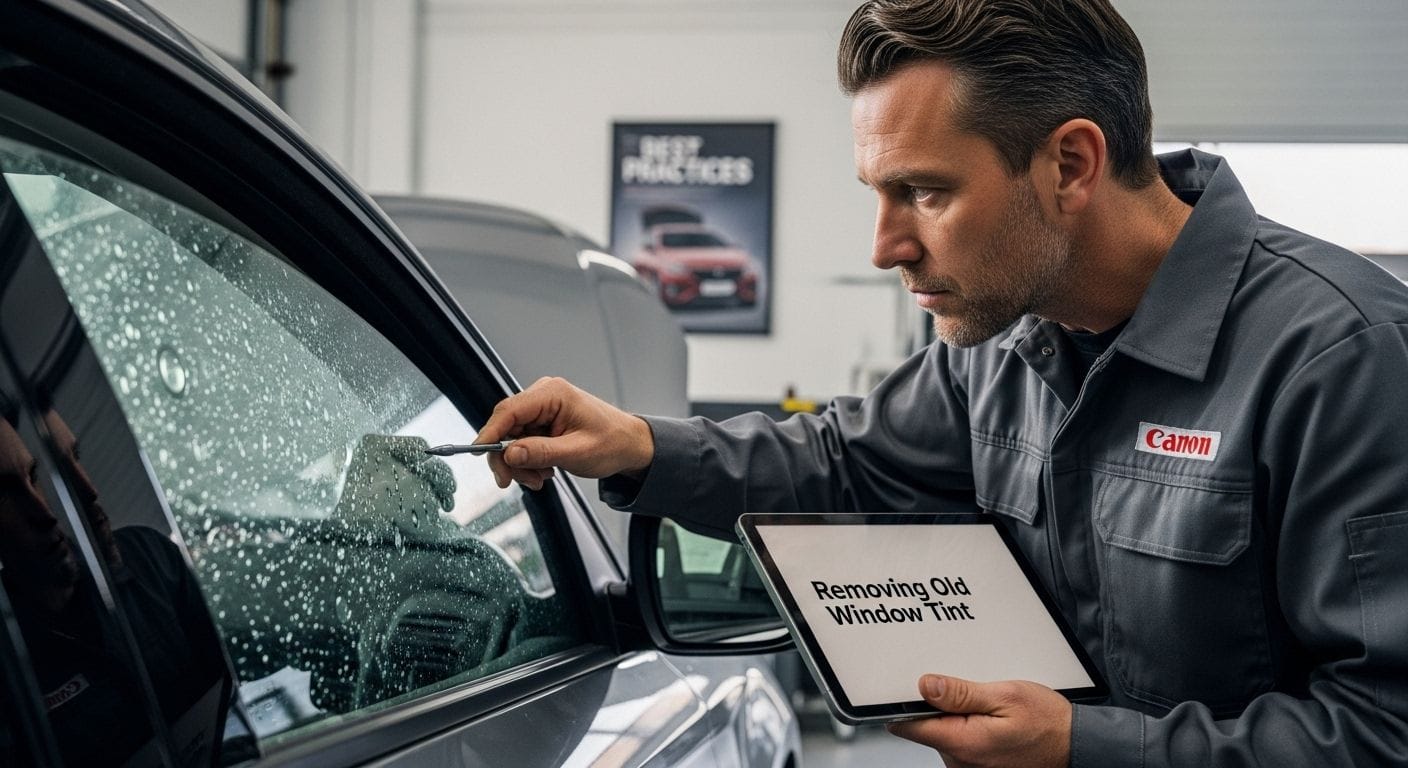
More than 80 percent of vehicles on the road feature some form of window tinting, reflecting its growing importance for both safety and comfort. Tinted windows are not just about style, they help block harmful UV rays, reduce heat, and add privacy in homes and cars. With so many films and regulations to consider, understanding the basics of window tinting helps ensure you make smart choices for both protection and performance.
Table of Contents
- Defining Window Tinting And Its Purpose
- Types Of Window Tint Films Explained
- Step-By-Step Window Tint Installation Process
- Legal Requirements And Compliance Worldwide
- Common Challenges And Mistakes To Avoid
Key Takeaways
| Point | Details |
|---|---|
| Purpose of Window Tinting | Window tinting enhances glass performance by reducing heat, minimizing glare, blocking UV radiation, and improving safety and privacy. |
| Types of Tint Films | Various film types exist including dyed, metallized, ceramic, and smart glass, each serving distinct performance and aesthetic needs. |
| Installation Process | A meticulous installation process includes workspace preparation, precise film cutting, and careful adhesion techniques to ensure optimal results. |
| Legal Compliance | Installers must be aware of local regulations regarding visible light transmission and specific vehicle guidelines to maintain compliance and safety. |
Defining Window Tinting and Its Purpose
Window tinting represents a sophisticated automotive and architectural solution designed to enhance glass surfaces through strategic film application. According to Wikipedia, window film is a thin laminate applied to glass surfaces in vehicles and buildings with multiple critical functions.
The primary purposes of window tinting are multifaceted and strategically engineered to provide comprehensive protection and comfort. Specifically, window tints serve several key objectives:
- Reducing solar heat transmission
- Minimising glare from direct sunlight
- Blocking harmful ultraviolet (UV) radiation
- Enhancing privacy for occupants
- Improving overall safety by reinforcing glass structural integrity
From a safety perspective, Wikipedia notes that safety window films are particularly valuable because they can hold shattered glass together, preventing potential injury during accidents or impacts. Professional installers understand that these films are not merely aesthetic additions but critical protective layers that significantly improve vehicle and building glass performance.
For automotive professionals and window tint specialists, understanding these fundamental purposes is crucial. Window tinting transforms ordinary glass into a high-performance surface that offers protection, comfort, and style. Whether applied to personal vehicles, commercial fleets, or architectural glass, these films represent a sophisticated intersection of material science and practical engineering. Professional window tint guides can provide deeper insights into selecting and applying the most appropriate tinting solutions for specific environments and requirements.
Types of Window Tint Films Explained
Window tint films represent a complex technological landscape with diverse materials engineered to address specific performance requirements. According to Wikipedia, window films are categorically distinguished by their primary construction components, each offering unique characteristics and benefits for professional installers and end-users.
The primary types of window tint films include:
- Dyed Films: Budget-friendly option providing basic colour and minimal heat reduction
- Pigmented Films: Enhanced colour stability and improved heat rejection
- Metallized Films: Reflective surfaces that significantly block solar radiation
- Ceramic Films: High-performance materials offering superior heat and UV rejection
- Nano-ceramic Films: Advanced technology providing exceptional optical clarity and thermal performance
Moreover, Wikipedia highlights an emerging technological frontier with smart glass, a revolutionary alternative that dynamically changes optical properties through electrical or thermal signals.
![]() This innovation represents a significant leap beyond traditional static window films, enabling real-time adjustments to light and heat transmission.
This innovation represents a significant leap beyond traditional static window films, enabling real-time adjustments to light and heat transmission.
For automotive and architectural professionals, understanding these film variants is crucial. Types of window tint guide for installers can provide deeper insights into selecting the most appropriate film based on specific environmental conditions, performance requirements, and client needs. Each film type offers a unique balance between aesthetic appeal, thermal management, and protective capabilities.

Step-By-Step Window Tint Installation Process
Professional window tint installation is a precise technical process that demands meticulous attention to detail and specialized skills. According to Wikipedia, window film installation can be performed by professional service companies or through DIY approaches, though professional expertise significantly impacts the final quality.
The comprehensive window tint installation process involves several critical stages:
- Preparation and Workspace Setup
- Clean, dust-free indoor environment
- Temperature-controlled workspace
- Proper lighting for detailed work
- Comprehensive tool kit
- Glass Surface Preparation
- Thorough cleaning with professional-grade solutions
- Removing all contaminants, oils, and residues
- Careful inspection for surface imperfections
- Precise surface decontamination
- Film Cutting and Sizing
- Accurate measurement of glass surfaces
- Precise film cutting using specialized tools
- Allowance for trim and adjustment
- Minimizing material waste
- Film Application Technique
- Application of mounting solution
- Careful film placement
- Systematic air bubble removal
- Ensuring perfect adhesion
As Wikipedia highlights, proper installation requires careful preparation, including thorough glass cleaning and precise film cutting. Professional installers understand that the application process involves using specialized solutions to prevent bubbles and guarantee optimal adhesion.
For professionals seeking advanced insights, heat shrinking window tint tutorial can provide additional techniques for achieving flawless window tint installations. Mastering these steps ensures high-quality results that meet professional standards and client expectations.
Legal Requirements and Compliance Worldwide
Window tinting regulations represent a complex landscape of legal requirements that vary significantly across different jurisdictions. Professional installers must navigate these intricate regulations with precision and thorough understanding to ensure full legal compliance and client safety.
Key Regulatory Considerations for Window Tinting:
- Visible Light Transmission (VLT) percentage restrictions
- Vehicle-specific legal guidelines
- Medical exemption provisions
- Windshield and side window tinting limitations
- Colour and reflectivity restrictions
According to Wikipedia, automobile window tinting laws demonstrate substantial variation by country and region. For instance, in New South Wales, Australia, regulations specify a permissible VLT of 35% for windows other than the windscreen, illustrating the nuanced nature of these legal frameworks.
Moreover, Wikipedia provides another specific example from India, where the Motor Vehicles Act 1988 mandates strict VLT requirements. The legislation stipulates that front and rear windshields must maintain a 70% VLT, while other windows are limited to 50% VLT. These precise regulations underscore the critical importance of understanding local legal standards.
Professional window tint installers must remain continuously informed about evolving regulatory landscapes. Professional tint compliance guide can provide ongoing insights into navigating these complex legal requirements, ensuring that installation practices remain both technically excellent and legally compliant.
Common Challenges and Mistakes to Avoid
Window tint installation demands precision, technical expertise, and an understanding of potential pitfalls that can compromise the quality and longevity of the final product. Professional installers must remain vigilant to prevent common errors that could undermine their craftsmanship.
Critical Installation Challenges:
- Inadequate surface preparation
- Incorrect film selection
- Improper application techniques
- Environmental contamination
- Insufficient quality control
According to Wikipedia, improper installation can lead to significant issues such as bubbling, peeling, and reduced film effectiveness. Thorough glass cleaning and precise film application are fundamental strategies to mitigate these potential problems.
Wikipedia further emphasizes the critical importance of selecting the appropriate window film for specific glass types. Choosing an incompatible film can result in thermal stress and potential glass breakage, underscoring the necessity of comprehensive material compatibility assessments before installation.
Professionals seeking to refine their technique and avoid common pitfalls can benefit from removing old window tint best practices, which provide insights into comprehensive preparation and error prevention strategies. Continuous learning and meticulous attention to detail remain the cornerstone of exceptional window tint installation.
Elevate Your Window Tinting Craft with Precision Cutting Software
Understanding the essentials of window tinting brings the technical challenges into sharp focus – from selecting the right film type to ensuring flawless installation and legal compliance. These complexities often translate into frustration when material waste occurs or patterns do not align perfectly during application. If you are seeking to reduce errors, save time and maximise the quality of every job, modern cutting technology can transform your workflow.

Explore how the window Tint – AEONCUT PPF Pre-cut Cutting software addresses these challenges with high-precision pre-cut patterns designed explicitly for window tint professionals and enthusiasts. By minimising waste and increasing accuracy, AEONCUT empowers installers to deliver consistent, high-standard results while easing the complexity of film cutting processes. Start refining your craft today with innovative tools at aeoncutsw.com and discover more resources tailored for professional success in window tinting.
Frequently Asked Questions
What is window tinting and what are its main purposes?
Window tinting involves applying a thin laminate to glass surfaces in vehicles and buildings to enhance protection and comfort. Its main purposes include reducing solar heat transmission, minimizing glare, blocking harmful UV radiation, enhancing privacy, and improving glass safety.
What are the different types of window tint films available?
The primary types of window tint films include dyed films, pigmented films, metallized films, ceramic films, and nano-ceramic films. Each type offers varying levels of heat rejection, UV protection, and aesthetic appeal to meet different performance requirements.
How is window tint film installed?
Window tint installation involves several key stages, including preparing the workspace, cleaning the glass surfaces, cutting the film to size, and applying the film using a mounting solution to ensure optimal adhesion and bubble-free application.
What are the legal requirements for window tinting?
Legal requirements for window tinting vary widely and generally involve restrictions on visible light transmission (VLT) percentages, specific guidelines for vehicle windows, and color and reflectivity limitations. It is essential for installers to understand and comply with local regulations to ensure legality and safety.
Recommended
- How Window Tint Works: Essential Guide for Auto Professionals 2025 – AEONCUT PPF Pre-cut Cutting software
- What is Window Tint? Essential Guide for Tinting Pros 2025 – AEONCUT PPF Pre-cut Cutting software
- Types of Window Tint: Guide for Installers and Dealers 2025 – AEONCUT PPF Pre-cut Cutting software
- 2025 Guide to Window Tint Colour Options for Industry Pros – AEONCUT PPF Pre-cut Cutting software



